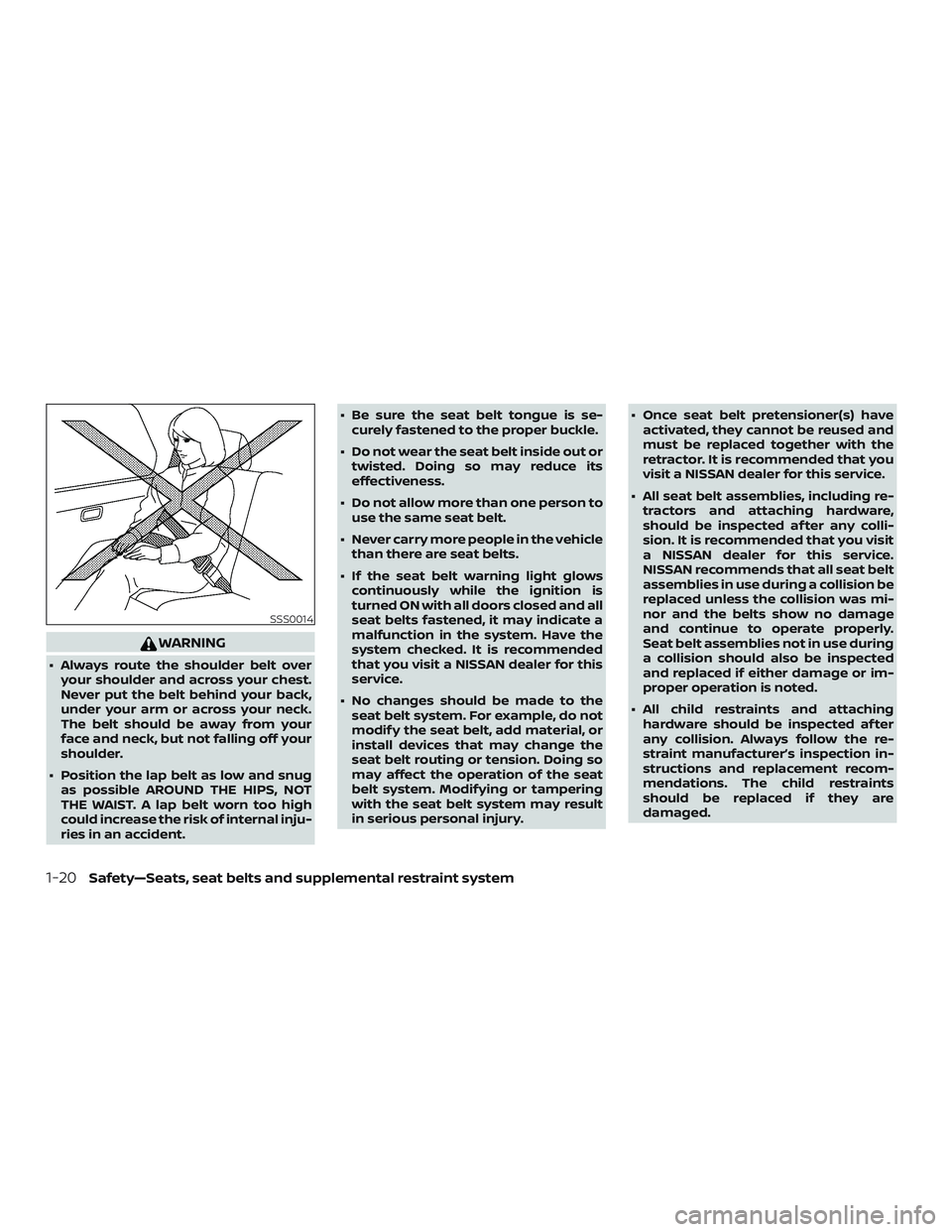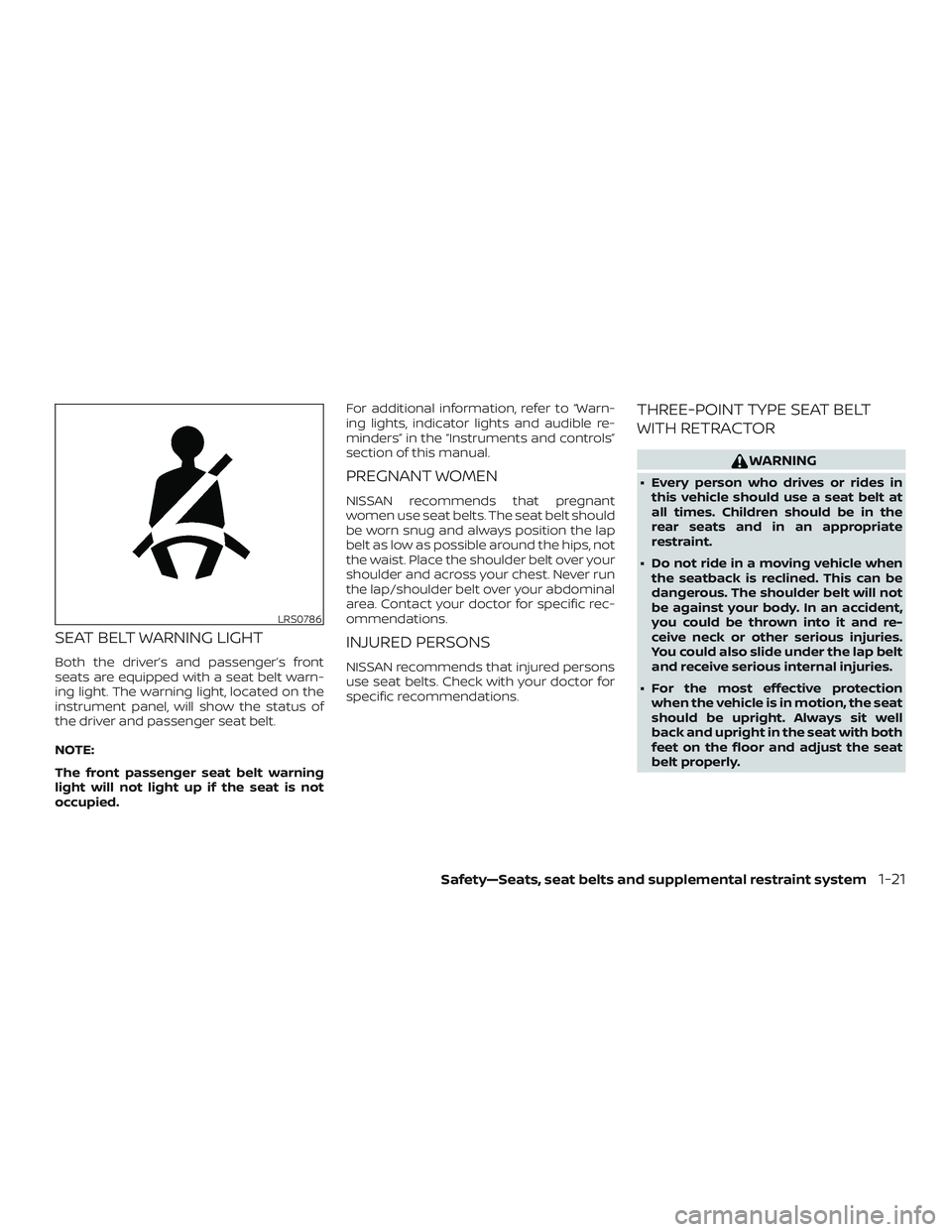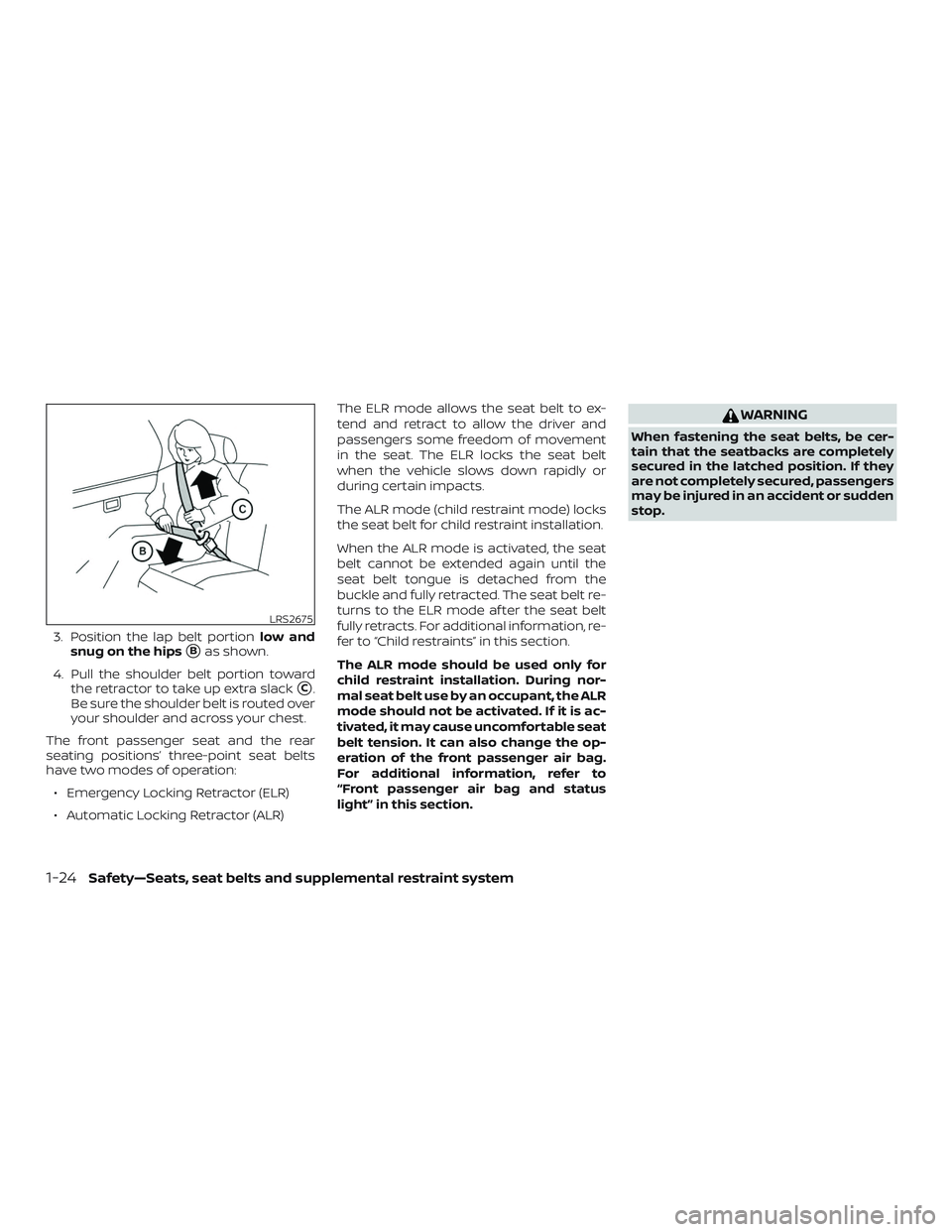Page 11 of 476
0 Illustrated table of contents
Air bags, seat belts and child restraints..........0-2
Exterior front ....................................0-3
Exterior rear .....................................0-4
Passenger compartment ........................0-5 Instrument panel
................................0-6
Engine compartment check locations ...........0-8
Warning and indicator lights .....................0-9
Page 16 of 476
1. Vents (P. 4-31)
2. Headlight/fog light (if soequipped)/turn signal switch
(P. 2-39)
3. Instrument brightness control
(P. 2-42)
4. Driver supplemental air bag (P.1-53) Horn (P. 2-43)
5. Meters and gauges (P. 2-4) Warning and indicator lights
(P. 2-11)
Vehicle information display (P. 2-19)
6. Twin trip odometer reset switch
(P. 2-5)
7. Wiper and washer switch (P. 2-36) Rear window wiper and washer
switch (P. 2-36)
8. Control panel*
9. Center display* Navigation system*
(if so equipped)
10. Front passenger air bag status
light (P. 1-53)
11. Front passenger supplemental air
bag (P. 1-53)
12. Glove box (P. 2-57)
13. Automatic heater and air
conditioning controls (P. 4-32)
LII2409
INSTRUMENT PANEL
0-6Illustrated table of contents
Page 19 of 476
Warninglight Name Page
or
Anti-lock Braking
System (ABS)
warning light 2-12
Automatic Emer-
gency Braking
(AEB) system
warning light2-12
or
Brake warning
light
2-12
Charge warning
light 2-13
Low tire pressure
warning light2-13
Master warning
light2-15
Warning
light Name Page
Power steering
warning light 2-15
Seat belt warning
light and chime2-15
Supplemental air
bag warning light2-16
Indicator
light Name Page
Front fog light in-
dicator light (if so
equipped) 2-16
Front passenger
air bag status
light2-16
High beam indi-
cator light (blue)
2-16
Indicator
light Name Page
Hill descent con-
trol system ON
indicator light (if
so equipped) 2-16
Malfunction Indi-
cator Light (MIL)
2-17
Overdrive OFF
indicator light2-18
Security indicator
light2-18
Side light and
headlight indica-
tor light (green)2-18
Slip indicator light 2-18
TOW mode ON
indicator light
2-18
WARNING AND INDICATOR LIGHTS
Illustrated table of contents0-9
Page 22 of 476

1 Safety—Seats, seat belts and
supplemental restraint system
Seats............................................ 1-2Front manual seat adjustment
(if so equipped) ................................1-3
Front power seat adjustment
(if so equipped) ............................... 1-5
2nd row bench seat adjustment ...............1-7
3rd row bench seat adjustment .............. 1-9
Armrests ..................................... 1-10
Flexible seating ............................... 1-10
Head restraints/headrests ......................1-12
Adjustable head restraint/headrest
components ................................. 1-13
Non-adjustable head restraint/
headrest components ........................ 1-14
Remove...................................... 1-14
Removable (without Dual Head
Restraint/Headrest Rear Seat Mobile
Entertainment System (MES) only) ............1-15
Install ......................................... 1-15
Adjust ........................................ 1-15
Folding head restraint/headrest ..............1-17
Seatbelts ....................................... 1-18
Precautions on seat belt usage ...............1-18
Seat belt warning light ........................ 1-21Pregnant women
............................. 1-21
Injured persons ............................... 1-21
Three-point type seat belt with
retractor ..................................... 1-21
Seat belt extenders .......................... 1-26
Seat belt maintenance ......................1-27
Child safety ..................................... 1-27
Infants ...................................... 1-28
Small children ............................... 1-28
Larger children .............................. 1-28
Child restraints ................................. 1-30
Precautions on child restraints ..............1-30
LATCH (Lower Anchors and Tethers for
CHildren) system ............................ 1-32
Rear-facing child restraint installation
using LATCH ................................. 1-35
Rear-facing child restraint installation
using the seat belts ......................... 1-37
Forward-facing child restraint
installation using LATCH .....................1-40
Forward-facing child restraint
installation using the seat belts ..............1-43
Booster
seats............................... 1-49
Supplemental Restraint System (SRS) ...........1-53
Page 23 of 476
Precautions on SRS.......................... 1-53
Supplemental air bag warning labels .........1-71 Supplemental air bag warning light
..........1-72
Page 42 of 476

WARNING
∙ Always route the shoulder belt overyour shoulder and across your chest.
Never put the belt behind your back,
under your arm or across your neck.
The belt should be away from your
face and neck, but not falling off your
shoulder.
∙ Position the lap belt as low and snug as possible AROUND THE HIPS, NOT
THE WAIST. A lap belt worn too high
could increase the risk of internal inju-
ries in an accident. ∙ Be sure the seat belt tongue is se-
curely fastened to the proper buckle.
∙ Do not wear the seat belt inside out or twisted. Doing so may reduce its
effectiveness.
∙ Do not allow more than one person to use the same seat belt.
∙ Never carry more people in the vehicle than there are seat belts.
∙ If the seat belt warning light glows continuously while the ignition is
turned ON with all doors closed and all
seat belts fastened, it may indicate a
malfunction in the system. Have the
system checked. It is recommended
that you visit a NISSAN dealer for this
service.
∙ No changes should be made to the seat belt system. For example, do not
modif y the seat belt, add material, or
install devices that may change the
seat belt routing or tension. Doing so
may affect the operation of the seat
belt system. Modif ying or tampering
with the seat belt system may result
in serious personal injury. ∙ Once seat belt pretensioner(s) have
activated, they cannot be reused and
must be replaced together with the
retractor. It is recommended that you
visit a NISSAN dealer for this service.
∙ All seat belt assemblies, including re- tractors and attaching hardware,
should be inspected af ter any colli-
sion. It is recommended that you visit
a NISSAN dealer for this service.
NISSAN recommends that all seat belt
assemblies in use during a collision be
replaced unless the collision was mi-
nor and the belts show no damage
and continue to operate properly.
Seat belt assemblies not in use during
a collision should also be inspected
and replaced if either damage or im-
proper operation is noted.
∙ All child restraints and attaching hardware should be inspected af ter
any collision. Always follow the re-
straint manufacturer’s inspection in-
structions and replacement recom-
mendations. The child restraints
should be replaced if they are
damaged.
SSS0014
1-20Safety—Seats, seat belts and supplemental restraint system
Page 43 of 476

SEAT BELT WARNING LIGHT
Both the driver’s and passenger’s front
seats are equipped with a seat belt warn-
ing light. The warning light, located on the
instrument panel, will show the status of
the driver and passenger seat belt.
NOTE:
The front passenger seat belt warning
light will not light up if the seat is not
occupied.For additional information, refer to “Warn-
ing lights, indicator lights and audible re-
minders” in the “Instruments and controls”
section of this manual.
PREGNANT WOMEN
NISSAN recommends that pregnant
women use seat belts. The seat belt should
be worn snug and always position the lap
belt as low as possible around the hips, not
the waist. Place the shoulder belt over your
shoulder and across your chest. Never run
the lap/shoulder belt over your abdominal
area. Contact your doctor for specific rec-
ommendations.
INJURED PERSONS
NISSAN recommends that injured persons
use seat belts. Check with your doctor for
specific recommendations.
THREE-POINT TYPE SEAT BELT
WITH RETRACTOR
WARNING
∙ Every person who drives or rides in
this vehicle should use a seat belt at
all times. Children should be in the
rear seats and in an appropriate
restraint.
∙ Do not ride in a moving vehicle when the seatback is reclined. This can be
dangerous. The shoulder belt will not
be against your body. In an accident,
you could be thrown into it and re-
ceive neck or other serious injuries.
You could also slide under the lap belt
and receive serious internal injuries.
∙ For the most effective protection when the vehicle is in motion, the seat
should be upright. Always sit well
back and upright in the seat with both
feet on the floor and adjust the seat
belt properly.
LRS0786
Safety—Seats, seat belts and supplemental restraint system1-21
Page 46 of 476

3. Position the lap belt portionlow and
snug on the hips
�Bas shown.
4. Pull the shoulder belt portion toward the retractor to take up extra slack
�C.
Be sure the shoulder belt is routed over
your shoulder and across your chest.
The front passenger seat and the rear
seating positions’ three-point seat belts
have two modes of operation: ∙ Emergency Locking Retractor (ELR)
∙ Automatic Locking Retractor (ALR) The ELR mode allows the seat belt to ex-
tend and retract to allow the driver and
passengers some freedom of movement
in the seat. The ELR locks the seat belt
when the vehicle slows down rapidly or
during certain impacts.
The ALR mode (child restraint mode) locks
the seat belt for child restraint installation.
When the ALR mode is activated, the seat
belt cannot be extended again until the
seat belt tongue is detached from the
buckle and fully retracted. The seat belt re-
turns to the ELR mode af ter the seat belt
fully retracts. For additional information, re-
fer to “Child restraints” in this section.
The ALR mode should be used only for
child restraint installation. During nor-
mal seat belt use by an occupant, the ALR
mode should not be activated. If it is ac-
tivated, it may cause uncomfortable seat
belt tension. It can also change the op-
eration of the front passenger air bag.
For additional information, refer to
“Front passenger air bag and status
light” in this section.
WARNING
When fastening the seat belts, be cer-
tain that the seatbacks are completely
secured in the latched position. If they
are not completely secured, passengers
may be injured in an accident or sudden
stop.
LRS2675
1-24Safety—Seats, seat belts and supplemental restraint system